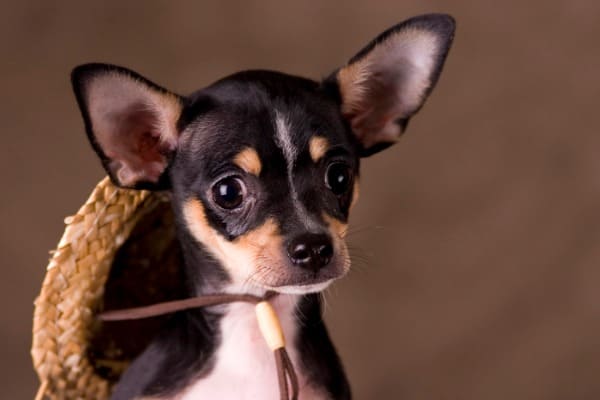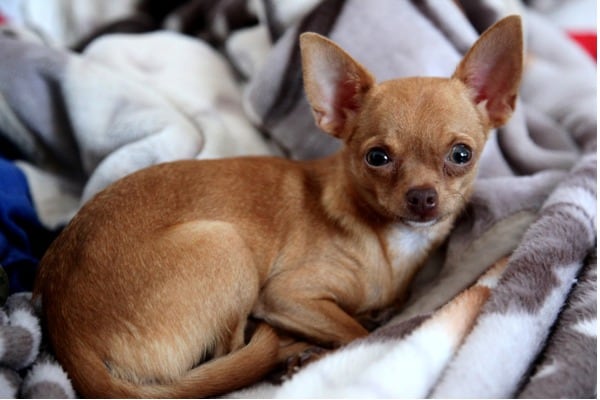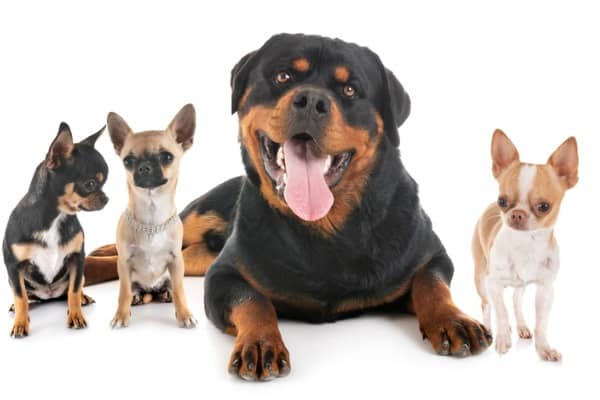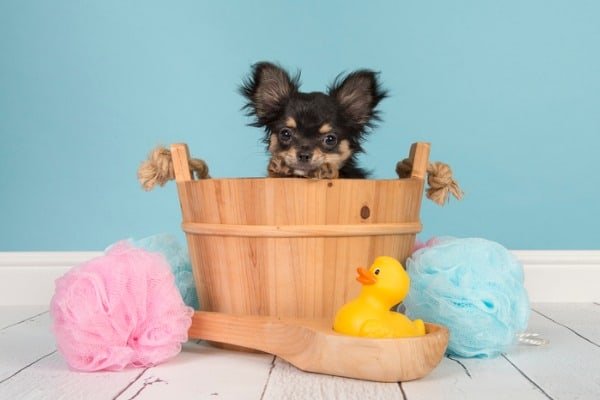Mixing two dog breeds always carry some uncertainties.
There can be some interesting outcomes when you mix two drastically different breeds.

What color will they be? How big can you expect them to grow? How much will they take after each parent?
A Chihuahua Rottweiler mix is one of these instances where anything is possible.
One is the smallest dog breed, and the other is a tanky specimen of the canine world.
How do these two breeds combine?
Two different dogs with contrasting features – both physiological and psychological – can come together to make a very remarkable animal.
Maybe you’ve found a Rottweiler Chihuahua mix you’d like to adopt, or you’re already the proud pet parent of one of these dogs.
In either case, there are some things you should know about life with a Rottweiler Chihuahua hybrid.
Breed Basics
To understand the qualities of any mixed-breed dog, you have to break down what their genes are made up of.
Knowing about their personality to potential health concerns can help you decide if this is the dog for you or not.
So let’s take a look at each side of this hybrid.
Rottweiler

They’re a variety of mastiffs, and they’re big. You could say that Rotties put the mass in mastiff because males can weigh over 130lbs fully grown.
Females aren’t much smaller, and both genders tend to be bulky. They’re not very tall or lanky, but rather, built solid and muscular.
Their size can be intimidating, but they’re quite capable of being very loving pets.
They do tend to be confident and can be a little stubborn, which is why early training is vital to their obedience.
We’ll cover that more in a bit.
The predecessors to the Rotties we see today date as far back as the Roman Empire. They’ve been in recent history to be sturdy, fearless, and protective.
Rottweilers spent some time as herding dogs for moving cattle and nearly faded from existence during the Industrial Revolution.
Nowadays, they are popular pets and also shine as search and rescue dogs. Rottweilers make great guide dogs for the handicapped.
Like a “giant” breed, they don’t have a life span as long as smaller dogs. They typically live 9-10 years.
Their size and genetics also put them at risk for developing hip dysplasia. Some eye and heart conditions are also something Rottie owners should look out for.
What color are they?
All Rotties have the classic black-and-rust coloring, with distinct “eyebrow” markings.
Their coats are medium in length, and they have a moderate undercoat. The fur can sometimes be wavy rather than straight.
Overall, they’re very loyal to their families, smart, and willing to work when trained properly.
Chihuahua

Move across the size spectrum of canines, and there it is – the Chihuahua.
The tiniest of all breeds, AKC standards expect them to weigh 6 lbs or less.
You’ve probably seen them in bags, backpacks, and purses. They’re popular companions because they’re so portable.
Chihuahuas tend to be very attached to their primary caregiver.
Their spunky personality can sometimes border on combative if they don’t get their way – one reason why curbing unwanted behavior early on is essential.
They’re smart with the tendency to be willful, just like the other breed we’re discussing here.
This Spanish breed has origins that date back to Aztec times. They get their name from the Mexican state of Chihuahua.
As a toy breed, they have a long lifespan. On average, the lifespan is 14-16 years, but many Chihuahuas have been known to reach their late teens.
A Chihuahua named Maverick holds the record for the longest lifespan, making it to an impressive 22 years.
This breed can also be at risk for eye and cardiac conditions, as well as joint issues.
Chihuahuas come in many colors and coats – solid, fawn, and spots are among the markings you can see.
There are short-haired and long-haired varieties of Chihuahua.
Since they are so small, they’re popular as companions. They thrive in cities and small spaces, and their exercise requirements are minimal.
If socialized early on, they can become friends with just about anyone.
What Does This Mean When You Combine the Two?

Appearance-wise, you can never know exactly what you get when you mix two breeds. When dealing with two very different dogs, this is especially true.
They could take after the larger parent, and you might have a dog much too large for riding around in a purse.
On the other hand:
They could always inherit genes from the smaller parent that will keep them small.
In general, if you’re considering this breed, expect something in the middle. You probably won’t have a dog that’s compact, but you probably won’t have a giant one, either.
The same can be said for their coats. They could take after the Rottie side and have the typical black and rust coloring.
Since Chihuahuas have many more variations in color, it’s impossible to predict how their coloring will look.
Coat length will also depend on the type of genes each parent carries. A long-haired Chihuahua and a Rottweiler could produce a fluffy dog or a short-haired one.
Rotties have floppy ears – they don’t stand up on their own. Chihuahuas, on the other hand, have naturally erect, pointy ears.
A puppy that’s half of each could have floppy ears, upright ears, or something in the middle.
Rottweilers have more “boxy” facial features, while those of Chihuahuas are sharp. Again, a mix of the two could result in the puppy favoring one parent or being a mix of each.
In any case, the features of each breed can have some beautiful and adorable results when mixed together.
Since the lifespans vary, you can expect an average of the two when it comes to a Chihuahua Rottweiler mix.
Each breed’s health concerns should be taken into account. Early screening for genetic conditions can help increase lifespan and quality of life.
Temperament
First and foremost, you can expect this particular hybrid to have a very robust personality.
They could border on willful and stubborn, which means training is vital.
Since Rotties thrive when they have something to do, they’ll behave best if they’re not bored.
A bored dog with Rottweiler DNA can become defiant, and hyper, and could be your furniture’s worst enemy.
But Chihuahuas are nearly the opposite when it comes to stimulation. Some like to play with toys, but they don’t need as much mental or physical exercise.
So understanding which side the hybrid takes after the most is the first step in understanding their personality.
Even if they take more after the Chihuahua mix side, they will still need firm training.
They could become aggressive and territorial if not given proper obedience training.
Rotties can be a little imperious if they’re not given adequate guidance, so a Rottweiler mix might need someone who can patiently show them the ropes.
Each breed in this equation can be very sweet and become quite close to their families.
Exposing them to children and other pets from an early age gives them excellent chances to be gentle, trustworthy pets.
If you have plenty of time to dedicate to training, this could be the ideal mixed-breed for you.
Anyone who doesn’t have the resources for good training might find themselves in over their heads.
Training
Basic manners are the first thing you’ll want to teach this type of mixed-breed – especially if they’re on the bigger side.
Leash training is a great place to start, whether they’re big or small.
A larger dog with bad leash manners can make walks with the dog stressful situations instead of quality time.
A small dog breed that is aggressive on the leash or likes to antagonize other dogs on walks is a different type of problem. No one wants their dog to gain a reputation as an ankle-biter.
Since they could be territorial, they’ll need to be desensitized to guests. Otherwise, they might bark and become frenzied whenever someone rings the doorbell.
But the good news?
Both breeds in this mix are smart and can learn quickly.
Reward-based training, also known as positive reinforcement, is widely accepted as the best way to train any breed of dog.
Puppies can pick up commands easily when you reward and praise them for succeeding.
This doesn’t work just for basic obedience – it can be helpful with potty training as well.
Rather than punish bad behavior, redirect it to something appropriate.
Instead of scolding a dog for having an accident, for example, take them outside as soon as possible.
And remember to praise each time they eliminate outdoors.
Is barking an issue? Don’t raise your voice – they’ll either think it’s a game (who can bark louder), or they’ll become anxious at your anger.
Distract a barking dog with a favorite toy or some mental games.
Aside from putting a stop to barking, it teaches them that if they stop any unwanted behavior, they’ll be rewarded.
Remember, corporal punishment does far more harm than good, and a dog can’t connect it with them misbehaving.
They can become anxious and aggressive, exacerbating the problem and straining their relationship with you.
Overall, this hybrid shouldn’t be particularly hard to train as long as you have time to dedicate to them.
Just remember the unique challenges you could face as a result of their personalities.
Care and Grooming
The care requirements of Rotties and Chihuahuas are different. So a combination of them can be difficult to know until you’re dealing with an individual dog.
Here are some things you can expect:
Bed, Bath, and Beyond

Rotties and Chihuahuas can be very cuddly. They might want to share your bed with you, and their favorite napping spot could be your lap.
A Chihuahua mix with Rottweiler DNA could be especially prone to separation anxiety.
So keeping them close at bedtime can help avoid stress for everyone involved.
Tricky grooming routines aren’t needed with either breed – but long-haired Chihuahuas will require more frequent brushing to prevent matting in their hair.
So if the hybrid inherits long hair, they will need, at the very least weekly brushing.
Occasional baths are needed for any dog. But Rotties can be quite slobbery.
While this doesn’t require a bath, they might need their mouths wiped down with a damp cloth from time to time.
There’s more:
Anyone who’s been around a drooly dog knows that if they shake, you might be in for a shower.
If you’re easily grossed out, you might want to consider a dog who isn’t as likely to spray you with drool.
Health
Exercise

Any dog on the larger side will need more exercise. So unless the hybrid has taken after the Chihuahua, when it comes to size, be ready for a steady walk routine.
Three walks a day are ideal, and having space to run off-leash is even better.
Playtime indoors is also important. Safe chew toys and tug-type toys are great staples to keep around.
Diet
Dietary needs also depend on the size of the dog – but be prepared for a medium-sized dog who will need adequate protein.
Health Concerns
As we mentioned earlier, both Chihuahuas and Rottweilers can be prone to cardiac and eye conditions.
So a hybrid of the two should be screened early for any abnormalities.
A larger dog with Rottweiler genes might face hip dysplasia, especially in mid-life.
Each of these conditions is treatable but will require some time and money investment to manage them.
Is the Chi-Weiler for You?
One thing is for sure; these dogs will need adequate training if they are to become good housemates.
If you have the time and are able to exercise your dog frequently, this breed could be an amazing companion.
If you live in an apartment, this hybrid could be a good middle-ground for large dog enthusiasts.
They will still need space to exercise, but a smaller home is less likely to make them uncomfortable.
Another thing to consider:
The evidence that it’s safe to breed these two dogs naturally is virtually nonexistent.
What does that mean?
If you encounter one of these dogs up for adoption, the mother was most likely artificially inseminated. It’s almost impossible for them to procreate naturally.
And if a Chihuahua was the mother?
She probably had to have a Cesarean section to deliver the puppies safely – even purebred.
Chihuahuas often have difficult births due to their tiny stature.
So be cautious when shopping for one of these hybrids.
A more ethical approach would be to rescue one from the shelter.
That way, you won’t be contributing to a puppy mill or an irresponsible breeder.
Plus, rescuing is probably going to cost less than purchasing a “designer dog.” It’s a win-win.
Tiny Plus Giant Equals…?
No one knows for sure what a Chihuahua Rottweiler mix will look like when fully grown – it’s quite the genetic mishmash when you consider the differences in each breed.
But one thing you can be sure of is that they have the potential to be perfect family dogs, whether you live in the city or the country.
If you rescue them?
You may never know what each parent looked or acted like, so you could be in for some surprises.
If you go in prepared for anything, the things you learn about your dog will bring you pride and joy that you added them to the family.
Provide them with plenty of love, exercise, and patience, and they will return the favor tenfold.
Since each side of their family are breeds who love to be with their people, they will soon become your close comrade.
